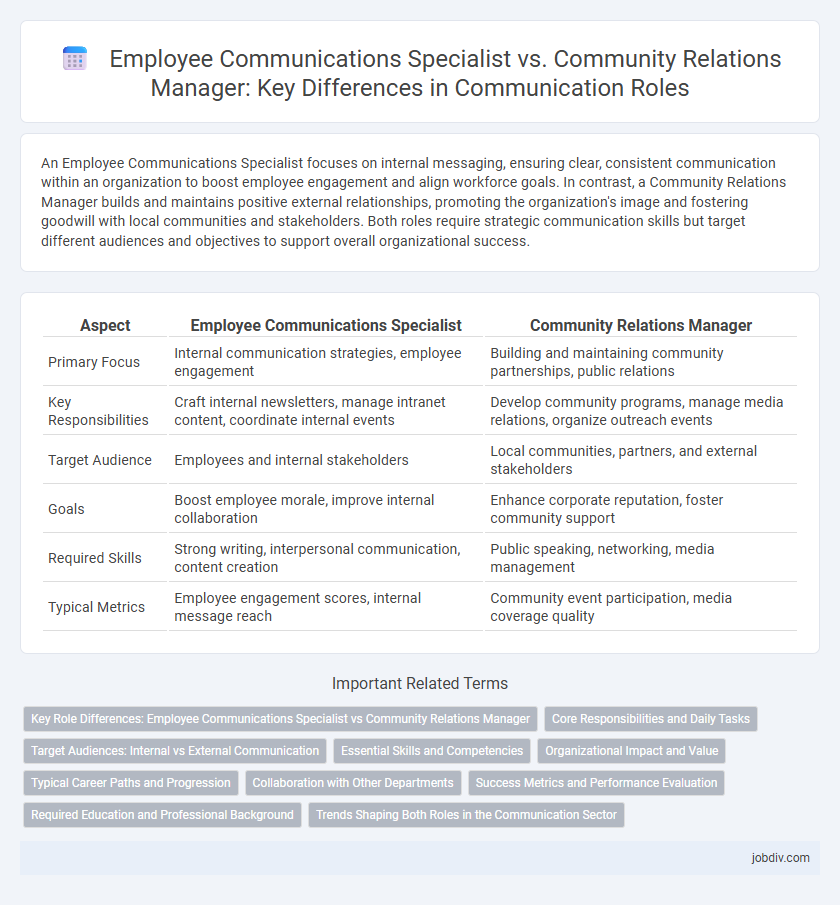An Employee Communications Specialist focuses on internal messaging, ensuring clear, consistent communication within an organization to boost employee engagement and align workforce goals. In contrast, a Community Relations Manager builds and maintains positive external relationships, promoting the organization's image and fostering goodwill with local communities and stakeholders. Both roles require strategic communication skills but target different audiences and objectives to support overall organizational success.
Table of Comparison
| Aspect | Employee Communications Specialist | Community Relations Manager |
|---|---|---|
| Primary Focus | Internal communication strategies, employee engagement | Building and maintaining community partnerships, public relations |
| Key Responsibilities | Craft internal newsletters, manage intranet content, coordinate internal events | Develop community programs, manage media relations, organize outreach events |
| Target Audience | Employees and internal stakeholders | Local communities, partners, and external stakeholders |
| Goals | Boost employee morale, improve internal collaboration | Enhance corporate reputation, foster community support |
| Required Skills | Strong writing, interpersonal communication, content creation | Public speaking, networking, media management |
| Typical Metrics | Employee engagement scores, internal message reach | Community event participation, media coverage quality |
Key Role Differences: Employee Communications Specialist vs Community Relations Manager
An Employee Communications Specialist primarily focuses on internal messaging, enhancing employee engagement, and aligning workforce communication with organizational goals. In contrast, a Community Relations Manager emphasizes building and maintaining relationships with external stakeholders, managing the company's public image, and leading community outreach initiatives. The key role differences lie in the target audience and strategic objectives: internal workforce communication versus external community engagement.
Core Responsibilities and Daily Tasks
Employee Communications Specialists develop internal communication strategies, create content for company newsletters, and manage employee engagement initiatives to ensure clear and consistent messaging across departments. Community Relations Managers build and maintain positive relationships with external stakeholders, organize community outreach programs, and coordinate public events to enhance the organization's public image and social impact. Both roles require strong interpersonal skills, strategic planning, and the ability to tailor communication to diverse audiences but differ in their primary focus on internal versus external communications.
Target Audiences: Internal vs External Communication
Employee Communications Specialists primarily focus on internal communication, targeting employees to improve engagement, convey company policies, and foster a cohesive workplace culture. Community Relations Managers concentrate on external communication, building relationships with stakeholders, media, and the public to enhance the organization's reputation and support community involvement. Both roles require tailored messaging strategies but differ significantly in their audience focus and communication objectives.
Essential Skills and Competencies
Employee Communications Specialists excel in crafting clear internal messages, mastering skills in content development, change management, and employee engagement. Community Relations Managers demonstrate expertise in stakeholder outreach, public relations, crisis communication, and partnership building to enhance organizational reputation. Both roles require strong verbal and written communication, strategic thinking, and proficiency in digital communication tools to effectively connect with target audiences.
Organizational Impact and Value
Employee Communications Specialists drive internal alignment by crafting targeted messaging that boosts employee engagement, productivity, and morale, directly influencing organizational culture and operational efficiency. Community Relations Managers enhance external reputation by building strategic partnerships and managing stakeholder relationships, which strengthens brand loyalty and supports long-term business growth. Both roles deliver essential communication strategies that elevate organizational impact but focus on distinct audiences--internal employees versus external communities.
Typical Career Paths and Progression
Employee Communications Specialists often begin their careers in internal communications or human resources, progressing to roles such as Communications Manager or Corporate Communications Director by gaining expertise in employee engagement and messaging strategies. Community Relations Managers typically start in public relations or nonprofit outreach, advancing to Senior Community Relations roles or Director of Corporate Social Responsibility by developing skills in stakeholder management and community partnership building. Both career paths benefit from continuous skill development in digital communication tools and strategic messaging to enhance organizational reputation and employee morale.
Collaboration with Other Departments
Employee Communications Specialists facilitate internal collaboration by coordinating messaging and information flow between HR, management, and various departments to ensure consistent and clear communication. Community Relations Managers engage cross-functional teams such as marketing, public affairs, and corporate social responsibility to align external community engagement efforts with organizational goals. Both roles rely heavily on integrating departmental inputs to foster cohesive communication strategies that support overall business objectives.
Success Metrics and Performance Evaluation
Employee Communications Specialists measure success through engagement rates, message clarity, and internal feedback surveys, ensuring effective information flow within organizations. Community Relations Managers evaluate performance by assessing public perception, partnership development, and impact on community initiatives, emphasizing external stakeholder relationships. Both roles rely on data-driven insights but focus on distinct audiences and communication objectives.
Required Education and Professional Background
An Employee Communications Specialist typically requires a bachelor's degree in communications, public relations, or a related field, with experience in internal communications and corporate culture development. In contrast, a Community Relations Manager often holds a degree in public relations, marketing, or social sciences, combined with expertise in stakeholder engagement and community outreach initiatives. Both roles benefit from strong interpersonal skills and proven experience in crafting targeted messaging for diverse audiences.
Trends Shaping Both Roles in the Communication Sector
Employee Communications Specialists and Community Relations Managers both adapt to digital transformation trends, utilizing social media platforms and analytics tools to enhance stakeholder engagement. The rise of remote work increases the demand for real-time, transparent internal communications, while external community relations emphasize brand reputation and corporate social responsibility through authentic interactions. Data-driven insights and personalized messaging remain critical in shaping effective communication strategies across both roles.
Employee Communications Specialist vs Community Relations Manager Infographic

 jobdiv.com
jobdiv.com